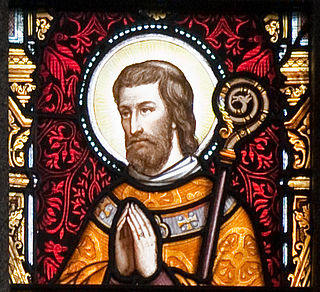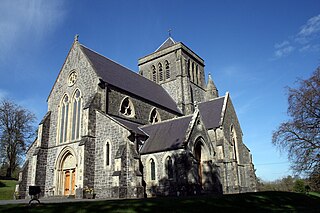
County Cavan is a county in Ireland. It is in the province of Ulster and is part of the Northern and Western Region. It is named after the town of Cavan and is based on the historic Gaelic territory of East Breffny (Bréifne). Cavan County Council is the local authority for the county, which had a population of 81,704 at the 2022 census.
The Diocese of Meath is an Irish diocese which took its name after the ancient Kingdom of Meath. In the Roman Catholic Church it still exists as a separate diocese, but in the Church of Ireland it has been united with other dioceses.

Cavan is the county town of County Cavan in Ireland. The town lies in Ulster, near the border with County Fermanagh in Northern Ireland. The town is bypassed by the main N3 road that links Dublin with Enniskillen, Ballyshannon and Donegal Town.

Saint Máedóc of Ferns, also known as Saint Aidan, Saint Madoc or Saint Mogue, was an Irish saint who was the first Bishop of Ferns in County Wexford and the founder of thirty churches. His birth name was Áed, the name of the Irish god of the underworld, meaning "fire". The name Aidan is a diminutive form of Aed or Aodh, and was also a form of the Latin name Dominus. Máedóc and Mogue are other pet forms of Aed or Aodh, formed from the Irish affectionate prefix mo- and the diminutive suffix -óg, meaning "young", making for something like "my dear little Aodh".

The Bishop of Kilmore is an episcopal title which takes its name after the parish of Kilmore, County Cavan in Ireland. In the Roman Catholic Church it remains a separate title, but in the Church of Ireland it has been united with other bishoprics.

The Diocese of Kilmore is a Latin Church diocese which is mainly in the Republic of Ireland although a few parishes are in Northern Ireland. It is one of eight suffragan dioceses which are subject to the Metropolitan Archdiocese of Armagh.
Saint Bricín was an Irish abbot of Tuaim Dreccon in Breifne, a monastery that flourished in the 7th century.

The Kingdom of East Breifne or Breifne O'Reilly was an historic kingdom of Ireland roughly corresponding to County Cavan that existed from 1256 to 1607. It took its present boundaries in 1579 when East Breifne was renamed Cavan, after Cavan town, and shired into Ulster. Originally part of the older Kingdom of Breifne, East Breifne came into existence following a protracted war between the ruling O'Rourke clan and the ascendant O'Reillys which culminated in the division of the kingdom in 1256. The Kingdom was ruled by the dynasty of the Ó Raghallaigh (O'Reilly) and lasted until the early 17th century.

Milltown is a small village in County Cavan, Ireland. The population as at 2021 was around 100. During a nineteenth century O'Donavan townlands survey of County Cavan it was noted that the Milltown area was traditionally referred to as Bellanaleck, there are no other records with this name. The Archaeological Inventory of County Cavan notes (507) Derrygeeraghan, a raised circular Rath area with two substantial earthen banks and a wide deep fosse dating from earlier medieval times. The present Milltown Electoral Division and catchment area comprises several neighboring townlands within an ancient Barony of Loughtee Lower, County Cavan and Drumlane Civil Parish in County Cavan.
Cormac Mác Shamhradháin O.S.A., b. c.1410-d.1476, was the Roman Catholic Bishop of Ardagh diocese in Ireland from 1444 to 1476.
Cormac Mág Shamhradháin O.S.A., b. c.1442-d.1511, was the Roman Catholic Bishop of Kilmore diocese, Ireland from 1476 to 1480 and the anti-bishop of Kilmore from 1480 to 1511.

Farrelly is an anglicised form of Ó Faircheallaigh, a family name of the Irish nobility from County Cavan. The patronym means "descendant of Faircheallaigh", whose name means "super war". Faircheallaigh was the son of Ailill, a 7th-great-grandson of Niall, King of Ireland. He was made the heir of Saint Máedóc of Ferns in the 7th century and his Ó Faircheallaigh descendants were the Abbots of Drumlane for 7 centuries until David Ó Faircheallaigh became Bishop of Kilmore. The surname was anglicised on emigration across the Anglosphere, where Major Patrick Farrelly founded the Farrelly political family of Pennsylvania with his son David Farrelly, author of the third Pennsylvania Constitution (1836); and General Terrence Farrelly was the first judge of Arkansas County, Speaker of the General Assembly of Arkansas Territory and author of the first Arkansas Constitution (1836); his son John Farrelly was a politician and his grandson John Patrick Farrelly was Bishop of Cleveland. The surname became Farley and John Farley became Cardinal Archbishop of New York.

The Cathedral of Saint Patrick and Saint Felim, also known as Cavan Cathedral, is a Roman Catholic cathedral located in Cavan, Ireland. It is the seat of the Bishop of Kilmore, and the mother church of the Roman Catholic Diocese of Kilmore.

St Fethlimidh's Cathedral, Kilmore is one of two cathedral churches in the Diocese of Kilmore, Elphin and Ardagh in the Church of Ireland. It is situated in the parish of Kilmore, southwest of the county town of Cavan. The name Kilmore - Cill Mhor meaning 'the great church' - reflects an earlier prominence that the Annals of the Four Masters have traced to an early medieval foundation. Of that church there are no physical remains

Port is a townland in the civil parish of Templeport, County Cavan, Ireland. It lies in the Roman Catholic parish of Templeport and barony of Tullyhaw.
Brian Breaghach Mág Samhradháin was chief of the McGovern or Magauran Clan of Tullyhaw in West Bréifne from 1272 to 3 May 1294. Tullyhaw is now a barony in County Cavan.

Kilnacross is a townland in the civil parish of Kildallan, barony of Tullyhunco, County Cavan, Ireland.

Kildallan is a townland in the civil parish of Kildallan, barony of Tullyhunco, County Cavan, Ireland.










